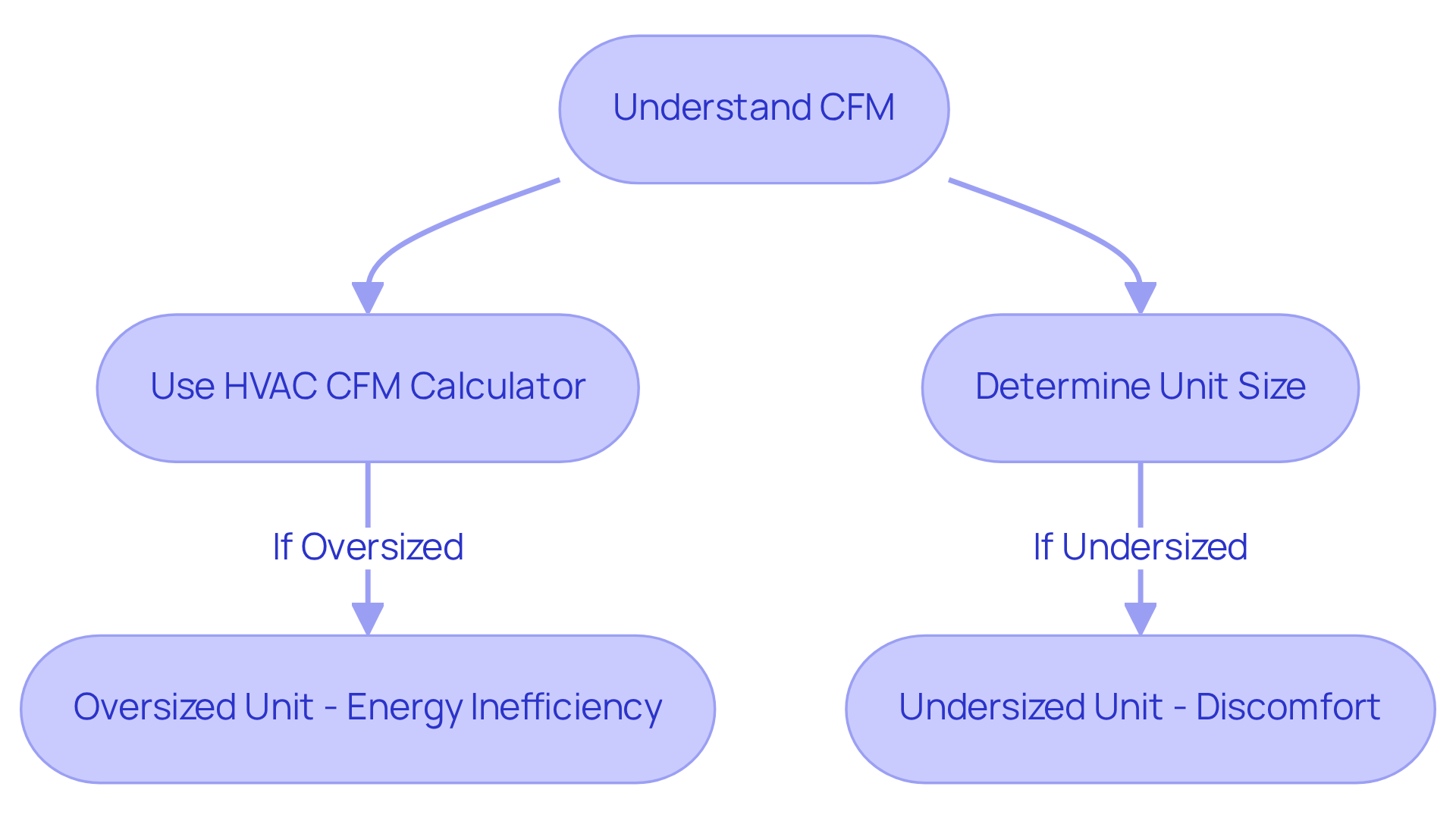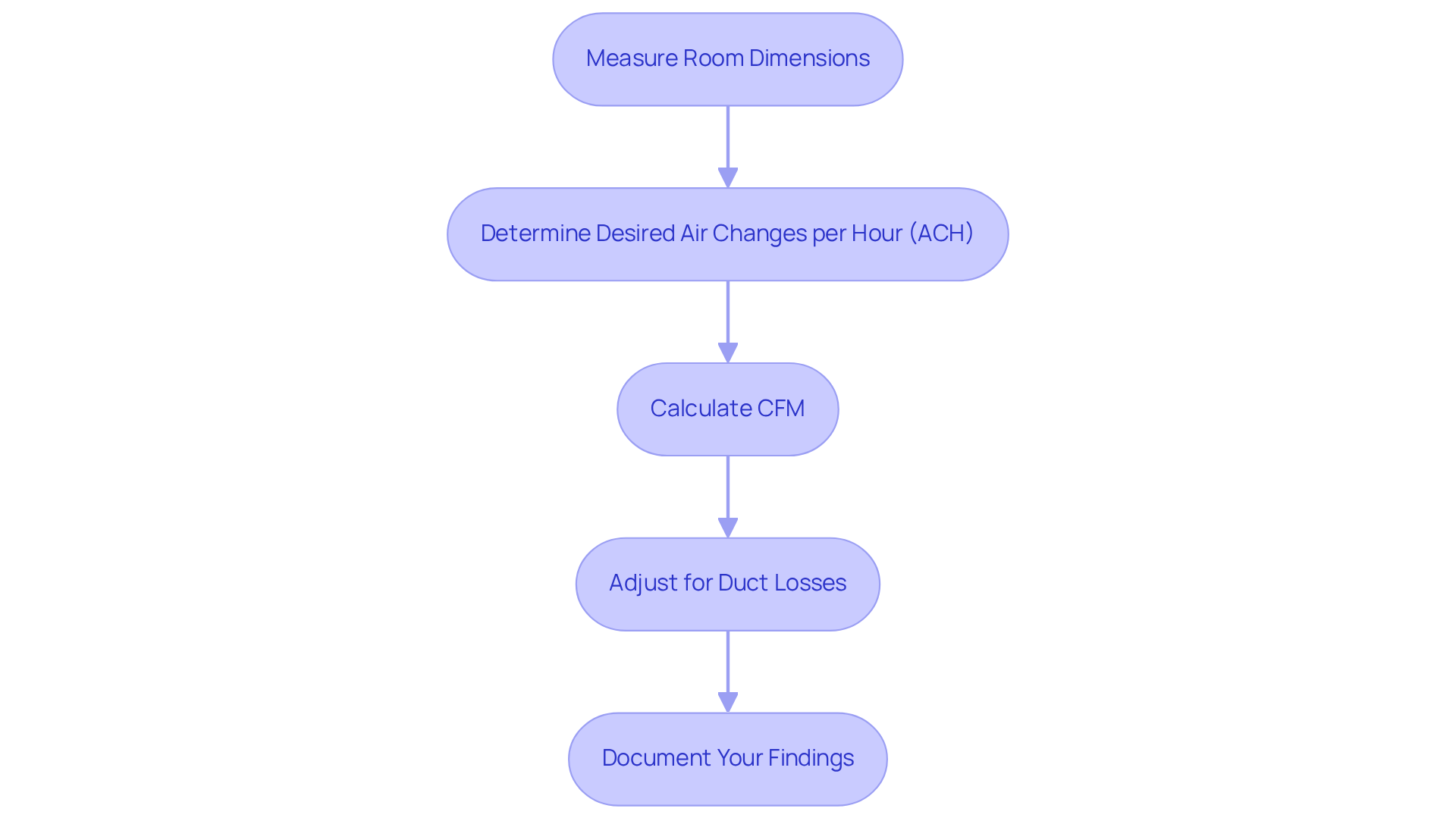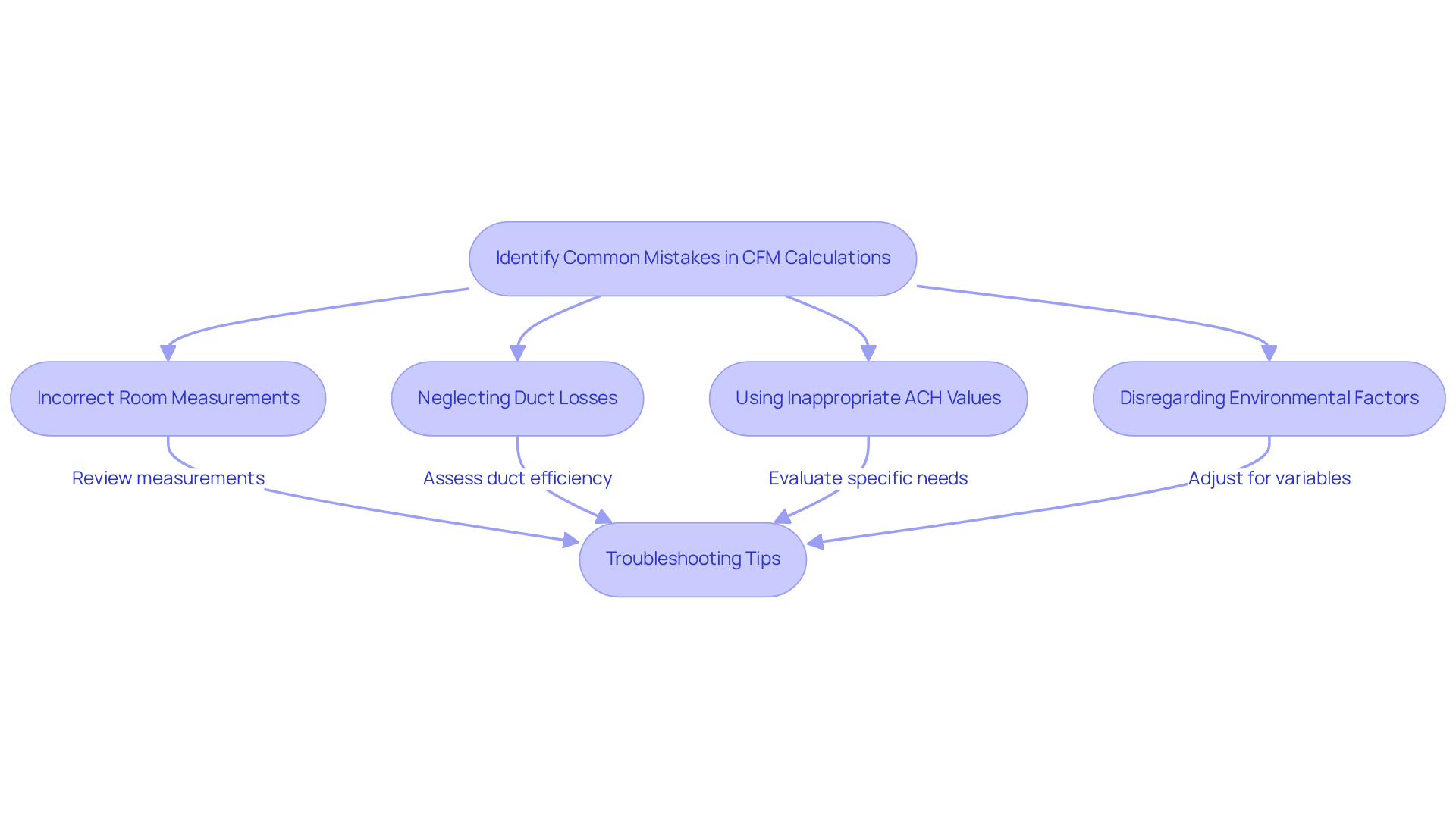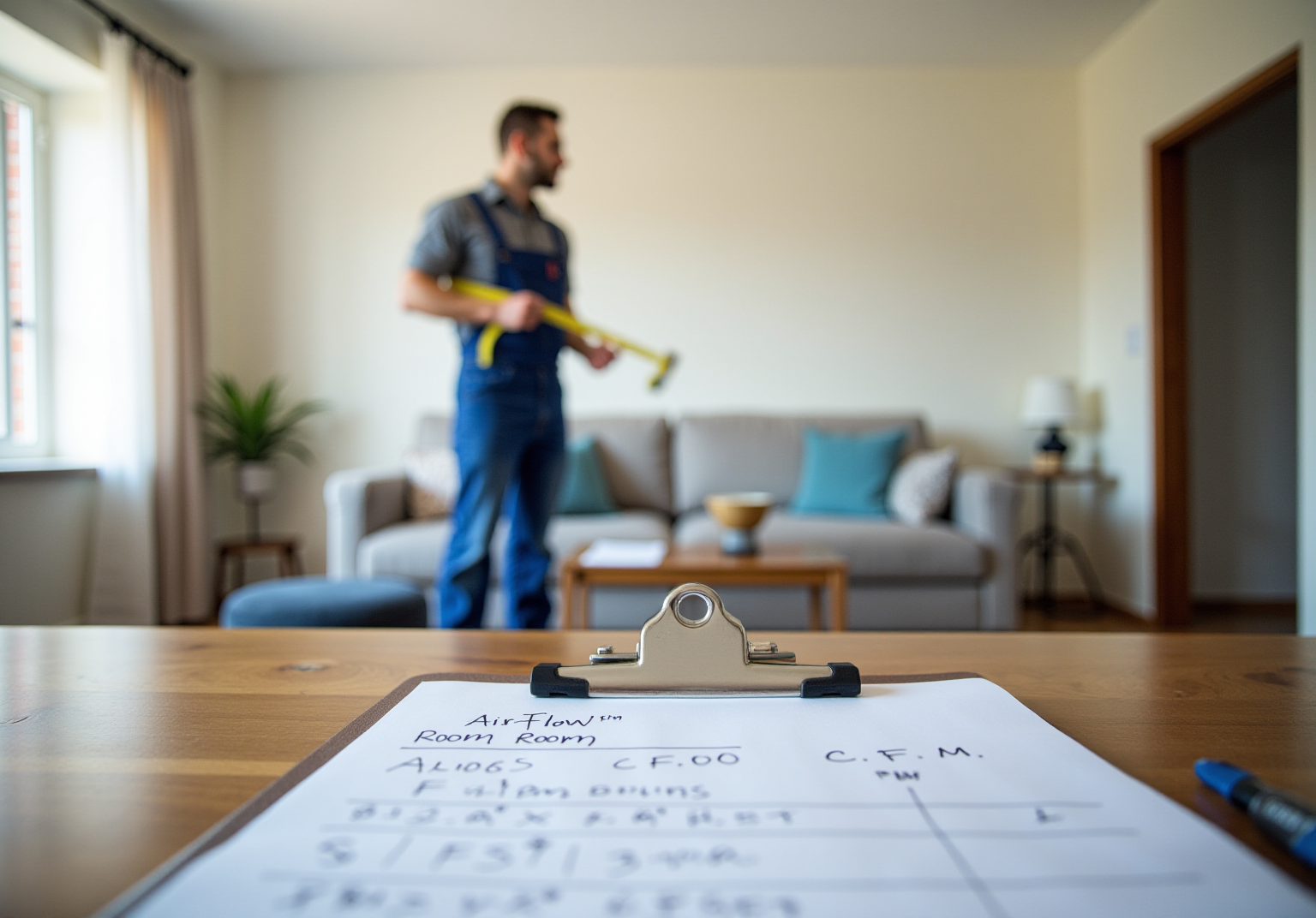Overview
This article serves as a heartfelt guide for HVAC contractors, addressing the challenges they face in ensuring optimal airflow and indoor air quality. The CFM (Cubic Feet per Minute) calculator is highlighted as a crucial tool in this endeavor.
Recognizing that accurate airflow measurements can significantly impact both system performance and client satisfaction, the article details a compassionate, step-by-step process for calculating CFM. It also addresses common mistakes and offers troubleshooting tips, reinforcing the importance of precision in their work.
By sharing insights and experiences, the article aims to nurture a supportive community among HVAC professionals, empowering them to enhance their service quality and achieve greater client happiness.
Introduction
Understanding airflow is not just a technical requirement; it is a fundamental aspect of creating comfortable and efficient indoor environments. Unfortunately, many contractors find themselves overwhelmed by the intricacies of CFM—Cubic Feet per Minute. This guide seeks to address that challenge, highlighting the importance of CFM calculations in HVAC systems.
We offer contractors a compassionate, step-by-step approach to mastering the HVAC CFM calculator. Yet, as they navigate the complexities of accurate measurements and the potential pitfalls that come with them, a crucial question arises: how can contractors ensure they are making the right calculations? By doing so, they can avoid costly mistakes and significantly enhance client satisfaction.
Define CFM and Its Importance in HVAC Systems
CFM, or Cubic Feet per Minute, is more than just a measurement of airflow; it represents the heart of how effectively an HVAC unit can create a comfortable environment. When contractors face the challenge of determining the right CFM, they often rely on an HVAC CFM calculator since the stakes are high. Oversized or undersized units can lead to energy inefficiency, increased operational costs, and discomfort for occupants. These issues can weigh heavily on a contractor’s mind, knowing that their clients rely on them for comfort and efficiency.
Understanding the HVAC CFM calculator is crucial for optimizing performance and enhancing indoor air quality. By ensuring that HVAC units operate effectively within their designed parameters, contractors can alleviate the concerns of both themselves and their clients. This knowledge not only enhances customer satisfaction but also fosters a sense of trust and reliability. When contractors understand the importance of the HVAC CFM calculator for accurate calculations, they empower themselves to provide solutions that truly meet the needs of their clients, creating a more harmonious and efficient living space.

Follow the Step-by-Step Process to Calculate CFM
To calculate CFM, let’s take a moment to ensure you have everything you need for this important task:
-
Measure the Room Dimensions: Begin by measuring the length, width, and height of the room in feet. This foundational step helps you find the total volume of the room in cubic feet, which is crucial for proper air circulation.
For instance, consider a room measuring 20 feet long, 15 feet wide, and 10 feet high. The volume would be calculated as 20 x 15 x 10 = 3000 cubic feet. This knowledge empowers you to create a comfortable environment.
-
Determine the Desired Air Changes per Hour (ACH): Reflect on how many times you want the air in the room to be replaced in one hour. For residential spaces, a common ACH is 5, aligning with CDC recommendations for maintaining adequate indoor air quality. The CDC emphasizes that at least 5 ACH is necessary for clean air in occupied spaces, ensuring the well-being of everyone inside.
-
Calculate CFM: Now, let’s use the formula:
CFM = (Room Volume x ACH) / 60
Continuing with our example, if the room volume is 3000 cubic feet and you desire 5 air changes per hour:
CFM = (3000 x 5) / 60 = 250 CFM. This calculation is a vital step in ensuring your space is healthy and pleasant.
-
Adjust for Duct Losses: If applicable, it’s important to consider any losses due to ductwork inefficiencies. This may mean adjusting your calculated CFM to guarantee that sufficient air movement reaches the intended areas, ultimately enhancing comfort and air quality.
-
Document Your Findings: Lastly, record your CFM calculations for future reference, aiding in system design or troubleshooting. Keeping accurate records not only streamlines future projects but also ensures compliance with ASHRAE guidelines, which recommend a minimum of 0.35 air changes per hour for homes. ASHRAE underscores the importance of adequate ventilation for maintaining indoor air quality, reinforcing your commitment to a safe environment.
By following these steps, HVAC specialists can effectively utilize an HVAC CFM calculator to assess the required air movement for residential areas, ensuring optimal indoor air quality and comfort for all.

Identify Common Mistakes and Troubleshoot CFM Calculations
When using an HVAC CFM calculator, contractors often face challenges that can significantly affect the performance of the HVAC system. It’s not uncommon to encounter several mistakes that can lead to frustration and inefficiency.
-
Incorrect Room Measurements: Accurate measurement of all room dimensions is crucial. Double-checking calculations is essential to avoid errors in volume that can lead to insufficient circulation. As Mike MacFarland of Energy Docs wisely notes, “He almost never performs a change of the setup without also conducting a duct replacement,” highlighting the importance of managing air circulation effectively.
-
Neglecting Duct Losses: It’s easy to overlook duct losses, but failing to account for them can result in underestimating the required CFM. Always consider the efficiency and arrangement of the duct system to ensure optimal circulation. Homes built before 2000 often face duct issues, making it vital to carefully assess these losses.
-
Using Inappropriate ACH Values: Each space has unique air change requirements. Relying on a standard ACH without evaluating the specific needs of each room can lead to inadequate ventilation. Embracing the house-as-a-system concept allows HVAC contractors to address homeowners’ concerns, enhancing comfort and air quality.
-
Disregarding Environmental Factors: Factors such as humidity, temperature, and occupancy levels can significantly influence ventilation needs. Adjusting your calculations to reflect these variables leads to more accurate results. In compact residences, mechanical ventilation is crucial due to energy regulations, which adds complexity to circulation calculations.
-
Troubleshooting Tips: If the CFM calculated using the HVAC CFM calculator seems off, revisit your measurements and underlying assumptions. Consider utilizing air movement measurement instruments, such as an anemometer, to compare actual air circulation with your calculations. Duct sizing calculators can also improve ductwork design by determining dimensions based on flow rate, space size, and airflow parameters.
Don’t hesitate to seek advice from colleagues or industry resources if you’re uncertain about specific calculations or adjustments needed for unique situations. Regularly reviewing and refining your measurement techniques can help minimize errors and enhance overall system performance. Remember, you’re not alone in this journey—support is available as you strive for excellence in your HVAC projects.

Conclusion
Mastering the HVAC CFM calculator is not merely a technical task; it is a vital step for contractors who genuinely care about delivering optimal indoor comfort and air quality. Understanding CFM, or Cubic Feet per Minute, is foundational—it directly affects the efficiency and effectiveness of HVAC systems. By accurately calculating CFM, contractors can ensure that the units they install are appropriately sized. This commitment leads to lower energy costs, improved comfort for occupants, and strengthens the trust clients place in their services.
Throughout this guide, we have outlined key steps for calculating CFM, including measuring room dimensions, determining desired air changes per hour, and adjusting for duct losses. It’s important to recognize the common mistakes that contractors may encounter during this process, such as incorrect measurements and overlooking environmental factors. By being aware of these pitfalls and employing thoughtful troubleshooting strategies, HVAC professionals can refine their approach and achieve better results in their projects.
Ultimately, mastering the HVAC CFM calculator signifies more than just performing calculations; it reflects a deep commitment to quality service and customer satisfaction. As the demand for energy-efficient and comfortable living spaces continues to rise, contractors are encouraged to embrace the insights shared in this guide. By prioritizing accurate CFM calculations, HVAC specialists not only enhance their expertise but also contribute to creating healthier and more efficient environments for their clients. Together, we can foster a community of professionals dedicated to excellence and care in our industry.
Frequently Asked Questions
What does CFM stand for and why is it important in HVAC systems?
CFM stands for Cubic Feet per Minute. It is a measurement of airflow that indicates how effectively an HVAC unit can create a comfortable environment. Proper CFM levels are crucial for ensuring energy efficiency and occupant comfort.
What are the consequences of having oversized or undersized HVAC units?
Oversized or undersized HVAC units can lead to energy inefficiency, increased operational costs, and discomfort for occupants. These issues can significantly affect the effectiveness of the HVAC system.
How do contractors determine the right CFM for HVAC units?
Contractors often rely on an HVAC CFM calculator to determine the appropriate CFM for HVAC units. This tool helps ensure that the units operate effectively within their designed parameters.
Why is understanding the HVAC CFM calculator important for contractors?
Understanding the HVAC CFM calculator is essential for optimizing performance and enhancing indoor air quality. It enables contractors to provide accurate solutions that meet their clients’ needs, improving customer satisfaction and trust.
How does proper CFM calculation affect client relationships?
Accurate CFM calculations help contractors alleviate concerns for both themselves and their clients. By ensuring HVAC units operate effectively, contractors can create a more harmonious and efficient living space, fostering trust and reliability with their clients.
List of Sources
- Follow the Step-by-Step Process to Calculate CFM
- Recommended Air Change Rates for Different Room Types (https://engineeringtoolbox.com/air-change-rate-room-d_867.html)
- ASHRAE Recommended Air Changes Per Hour – Smart Air (https://smartairfilters.com/en/blog/ashrae-per-hour-office-residential-school-virus?srsltid=AfmBOopkp3wYHDQlyDxLbabzAvODOHSGNUOKNeILqsLanecBKf1zKIlb)
- CFM Calculator (https://omnicalculator.com/construction/cfm)
- Air Changes Per Hour (ACH): What is it & How to Calculate it – Smart Air (https://smartairfilters.com/en/blog/what-is-air-changes-per-hour-ach-how-to-calculate?srsltid=AfmBOop1r8bWiVDZaBYW410L-AnP8NAGnMWyEghDIwjoSZzFaHY0Ebyd)
- Air Changes Per Hour | ACH Ranges & Average ACH | Moffitt (https://moffittcorp.com/air-changes-per-hour)
- Identify Common Mistakes and Troubleshoot CFM Calculations
- The 7 Biggest Mistakes That HVAC Contractors Make – Energy Vanguard (https://energyvanguard.com/blog/the-7-biggest-mistakes-that-hvac-contractors-make)
- What are some of the common mistakes made by hvac designers? | ir. yokelee tan (PEPC, MI FIRE) posted on the topic | LinkedIn (https://linkedin.com/posts/ir-yokelee-tan-pepc-mi-fire-441724111_what-are-some-of-the-common-mistakes-made-activity-7243444206562615297-Zv0k)
- Essential Ductwork Sizing Chart: Your Guide to Efficient HVAC Design — Blue Water Local SEO (https://bluewaterclimatecontrol.com/blog/ultimate-guide-to-ductwork-sizing-chart-for-efficient-hvac-systems)





